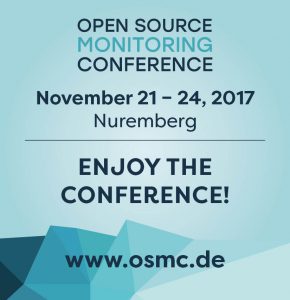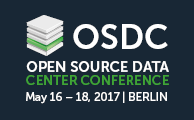Also for the 12th OSMC we started on Tuesday with a couple of workshops on Icinga, Ansible, Graphing and Elastic which were famous as always and afterwards with meet and greet at the evening dinner. But the real start was as always a warm Welcome from Bernd introducing all the small changes we had this year like having so many great talks we did three in parallel on the first day. Also we had the first time more English talks than German and are getting more international from year to year which is also the reason for me blogging in English.
The first talk of the day I attended was James Shubin talking about „Next Generation Config Mgmt: Monitoring“ as he is a great entertainer and mgmt is a really a great tool. Mgmt is primarily a configuration management solution but James managed in his demos to build a bridge to monitoring as mgmt is event driven and very fast. So for example he showed mgmt creating files deleted faster then a user could recognize they are gone. Another demo of mgmt’s reactivity was visualizing the noise in the room, perhaps not the most practical one but showing what you can do with flexible inputs and outputs. In his hysteresis demo he showed mgmt monitoring systemload and scale up and down the number of virtual machines depending on it. James is as always looking for people who join the project and help hacking, so have a look at mgmt (or the recording of one of his talks) and perhaps join what could really be the next generation of configuration management.
Second one was Alba Ferri Fitó talking about community helping her doing monitoring at Vodafone in her talk „With a little help from…the community“. She was showing several use cases e.g. VMware monitoring she changed from passive collection of snmptraps to proactively monitoring the infrastructure with check_vmware_esx. Also she helped to integrate monitoring in the provisioning process with vRealise using the Icinga 2 API, did a corporate theme to get a better acceptance, implemented log monitoring using the sticky option from check_logfiles, created her own scripts to monitor things she was told they could only be monitored by SCOM or using expect for things only having an interactive „API“. It was a great talk sharing knowledge and crediting community for all the code and help.
Carsten Köbke and our Michael were telling „Ops and dev stories: Integrate everything into your monitoring stack“. So Carsten as the developer of the Icinga Web 2 module for Grafana started the talk about his motivation behind and experience gained by developing this module. Afterwards Michael was showing more integration like the Map module placing hosts on an Openstreet map, dashboards, ticket systems, log and event management solutions like Greylog and Elastic including the Icingabeat and an very early prototype (created on the day before) for a module for Graylog.
After lunch which was great as always I attended „Icinga 2 Multi Zone HA Setup using Ansible“ by Toshaan Bharvani. He is a self-employed consultant with a history in monitoring starting with Nagios, using Icinga and Shinken for a while and now utilizing Icinga 2 to monitor his costumer’s environments. His ansible playbooks and roles showed a good practical example for how to get such a distributed setup up and running and he also managed to explain it in a way also people not using Ansible at all could understand it.
Afterwards Tobias Kempf as the monitoring admin and Michael Kraus as the consultant supporting him talked about a highly automated monitoring for Europe’s biggest logistic company. They used omd to build a multilevel distributed monitoring environment which uses centralized configuration managed with a custom webinterface, coshsh as configuration generator and git, load distribution with mod_gearman and patch management with Ansible.
Same last talk like every year Bernd (representing the Icinga Team) showed the „Current State of Icinga“. Bernd shortly introduced the project and team members before showing some case studies like Icinga being deployed on the International Space Station. He also promoted the Icinga Camps and our effort to help people to run more Icinga Meetups. Afterwards he started to dive into technical stuff like the new incarnation of Icinga Exchange including full Github sync, the documentation and package repository including numbers of downloads which were a crazy 50000 downloads just for CentOS on one day. Diving even deeper into Icinga itself he showed the new CA Proxy feature allowing multilevel certificate signing and automatic renewal which was sponsored by Volkswagen like some others, too. Some explanation on projects effort on Configuration management and which API to use in the Icinga 2 environment for different use cases followed before hitting the topic logging. For logging Icinga project now provides output for Logstash and Elasticsearch in Icinga 2, the Icingabeat, the Logstash output which could create monitoring objects in Icinga 2 on the fly and last but not least the Elasticsearch module for Icinga Web 2. In his demos he also showed the new improved Icinga Web 2 which adds even more eye candy. Speaking about eye candy also the latest version of Graphite module which will get released soon looks quite nice. Another release pending will be the Icinga Graphite installer using Ansible and Packaging to provide an easy way to setup Graphite. So keep an eye on release blogposts coming next weeks.
It is nice to see topics shift through the years. While the topics automation and integration were quite present in the last years it was main focus of many talks this year. This nicely fits my opinion that you as a software developer should care about APIs to allow easy integration and as an administrator you should provide a single interface I sometimes call „single point of administration“.
Colleagues have collected some pictures for you, if you want to see more follow us or #osmc on Twitter. So enjoy these while I will enjoy the evening event and be back tomorrow to keep you updated on the talks of second day.



















